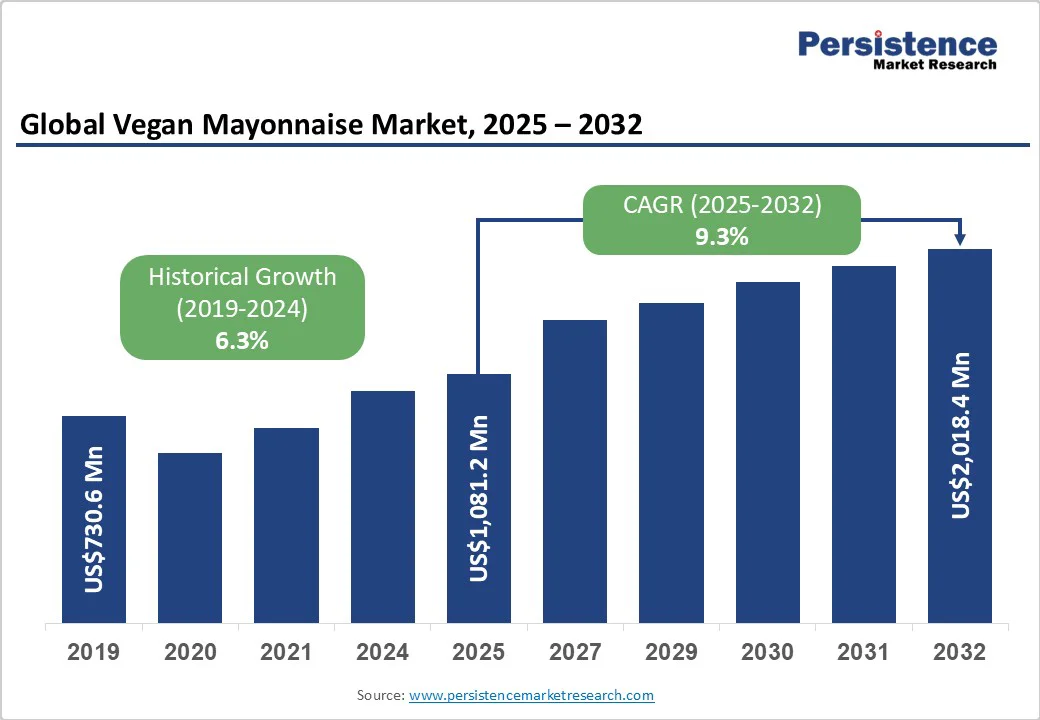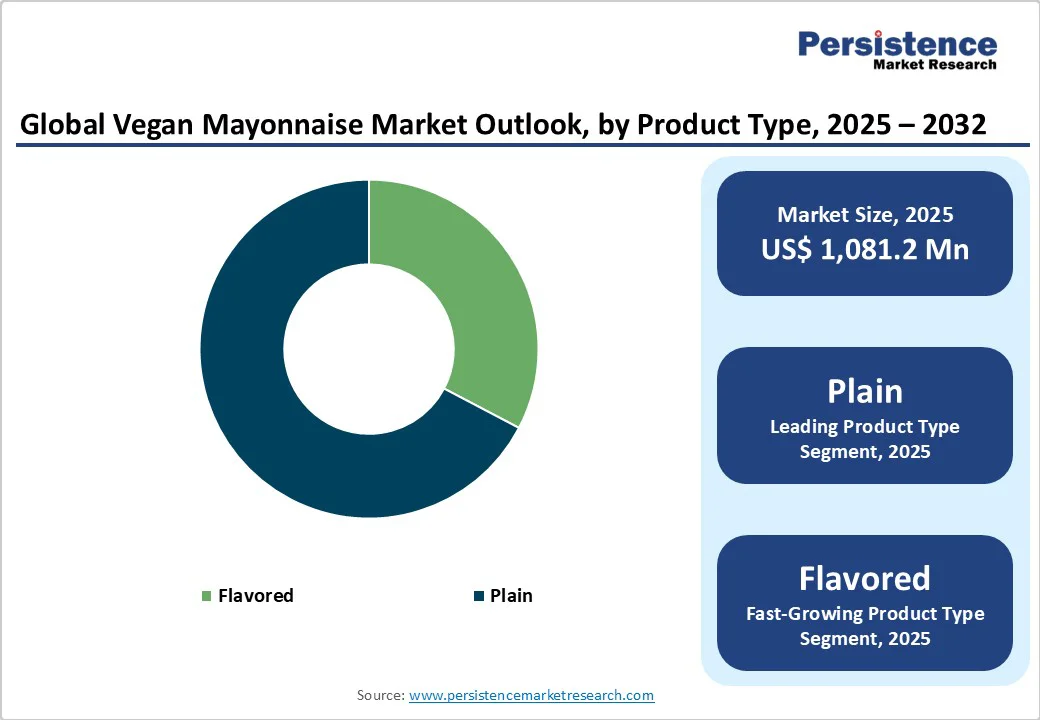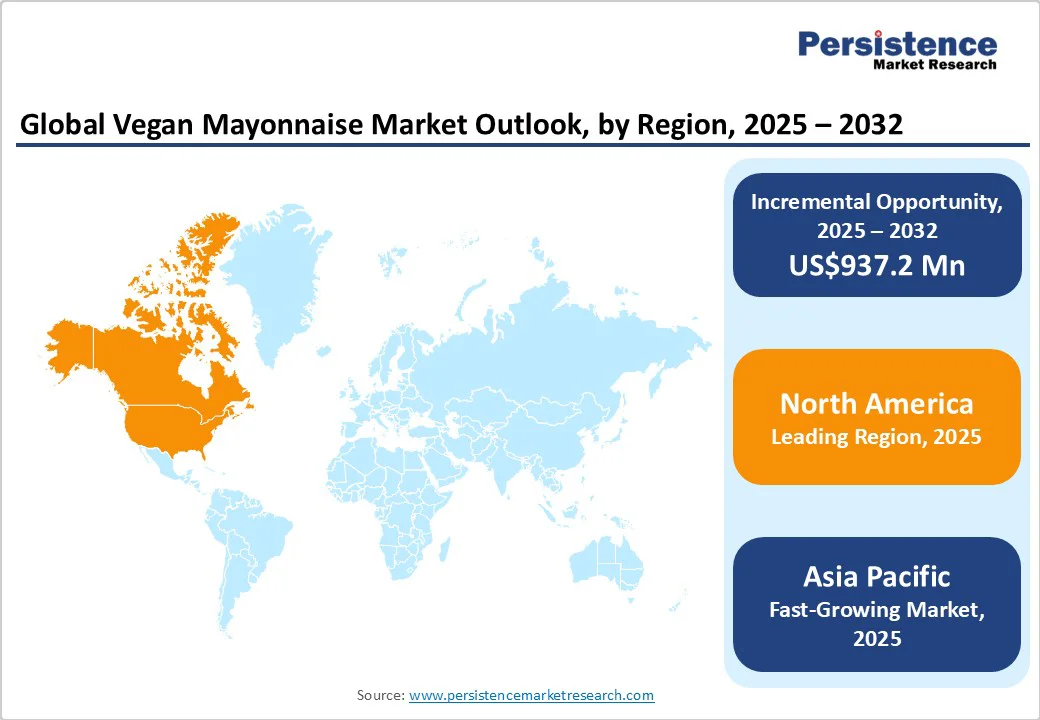ID: PMRREP19258| 188 Pages | 30 Sep 2025 | Format: PDF, Excel, PPT* | Food and Beverages

The global vegan mayonnaise market size is expected to be valued at US$1,081.2 million in 2025 and is projected to reach US$2,018.4 million by 2032, growing at a CAGR of 9.3% during the forecast period from 2025 to 2032.
Vegan mayonnaise is an eggless cream which is thick, often used as a condiment, and generally consists of a stable emulsion of vegetable oil, soy protein, & lemon juice or vinegar. Nowadays, vegan mayonnaise comes in a variety of flavors, blended with various herbs and spices.
| Key Insights | Details |
|---|---|
| Vegan Mayonnaise Market Size (2025E) | US$ 1,081.2 Mn |
| Market Value Forecast (2032F) | US$ 2,018.4 Mn |
| Projected Growth (CAGR 2025 to 2032) | 9.3% |
| Historical Market Growth (CAGR 2019 to 2024) | 6.3% |

The global surge in vegan and flexitarian lifestyles is propelling growth in the vegan mayonnaise market. As of early 2025, nearly 25.8 million people worldwide took part in Veganuary, an annual campaign encouraging a vegan diet throughout January, an extraordinary leap from just 3,300 participants in 2014.
This growth reflects a swelling consumer interest in plant-forward eating. In India, 11% of the population follows a vegan lifestyle, while the U.S. counts over 13.4 million vegans. Globally, 1-2% of the population has embraced veganism, reflecting a profound change in dietary habits and ethical priorities.
The growing demand for plant-based alternatives is further evident in the widespread adoption of dairy-free and egg-free products, with 40% of consumers regularly incorporating dairy substitutes into their diets.
This growing interest has prompted a wave of innovation from major brands and retailers eager to meet consumer demand. This rising tide of plant-based consumers, driven by health, ethical, and environmental motivations, has created fertile ground for vegan alternatives.
As people increasingly reduce or replace animal products, demand for egg-free spreads such as vegan mayonnaise becomes more mainstream, creating a powerful growth vector for producers who can meet evolving taste, health, and ethical preferences.
A critical challenge for the global vegan mayonnaise market is the volatility and limitations in sourcing key plant-based ingredients such as soy and pea protein. Soybean production and trade are heavily skewed Brazil and the U.S. account for approximately 85% of global soybean exports, while China imports over 60% of annual worldwide supplies.
China’s recent pivot away from U.S. soy amid trade tensions underscores geopolitical risks impacting supply chains. Meanwhile, despite record U.S. output, the USDA projects a record 124.9 million tons in 2024/25; any disruptions from climate shocks or policy shifts could affect global availability.
Additionally, more than 75% of global soy production is diverted to animal feed, leaving only a fraction for human-grade plant-protein use. These structural constraints concentrate production, geopolitical dependencies, and competing uses limit scalability, hinder cost stability, and challenge the consistency of vegan mayonnaise ingredient supply.
Collaborating with plant-based chefs on social media platforms such as YouTube to showcase vegan mayonnaise in everyday recipes offers a dynamic growth pathway for key players in the vegan mayonnaise market. Social media remains a preferred medium for food inspiration, where accounts of home cooks, flexitarians, and professional chefs are accessible, with visually engaging recipe content.
By partnering with influential vegan or plant-forward chefs, brands can highlight the versatility of vegan mayo beyond sandwiches, demonstrating its use in creamy dressings, dips, aioli, baked goods, and even fusion cuisines. Such collaborations humanize the product, turning it from a pantry item into a culinary tool, while also allowing brands to tap into the authenticity and loyal audiences these chefs command.
Storytelling through recipe demonstrations educates viewers on taste and texture and builds trust by showing how vegan mayo seamlessly replaces traditional mayonnaise without compromising on quality. This content can be repurposed across social media, brand websites, and foodservice training programs, multiplying its value.
A strong precedent exists in the packaged food industry: Hellmann’s Canada partnered with Michelin-recognized Chef Matthew Ravenscroft to launch its “Plantified” campaign.
Ravenscroft helped “plantify” classic barbecue dishes at renowned Canadian smokehouses such as Barque Smokehouse, Beach Hill Smokehouse, and Jane Bond BBQ, introducing vegan alternatives to iconic meaty menu items by incorporating Hellmann’s Vegan Mayo into innovative, plant-based versions of dishes.
By product type, plain vegan mayonnaise dominates due to its versatility, widespread consumer acceptance, and adaptability across various culinary applications. Plain vegan mayonnaise serves as a base for sauces, dressings, spreads, and dips, making it a staple in both households and foodservice settings. Its neutral flavor profile allows consumers to customize it with herbs, spices, or other ingredients, increasing its usage in diverse cuisines.
The rising awareness of plant-based diets, lactose intolerance, and allergy-friendly alternatives has further accelerated the demand for plain vegan mayonnaise. Manufacturers are focusing on clean-label ingredients, such as aquafaba, soy, and chickpea extracts, to appeal to health-conscious consumers seeking natural and non-GMO options.
Additionally, plain vegan mayonnaise often comes in multiple pack sizes, enhancing accessibility for both individual consumers and commercial buyers. As a result, this product segment continues to maintain the largest market share, driven by functionality, convenience, and growing plant-based consumption trends worldwide.
The jar segment leads the global market, driven by convenience, ease of use, and product preservation benefits. Jars provide airtight sealing, maintaining freshness, texture, and flavor over extended periods, which is especially important for plant-based formulations. They are easy to store, reseal, and handle, making them suitable for both household and foodservice applications.
Additionally, jars offer larger volumes, catering to bulk usage in restaurants, cafes, and catering services, while smaller jar sizes appeal to individual consumers seeking portion control and convenience. Manufacturers are increasingly adopting eco-friendly and recyclable jar materials to align with sustainability trends and consumer preferences for environmentally responsible packaging.
Transparent jars also allow consumers to view the product, enhancing trust and purchase intent. These factors collectively make jars the preferred packaging choice, enabling manufacturers to meet diverse consumer needs and maintain a leading position.

The North American vegan mayonnaise market is witnessing significant growth, driven by rising consumer awareness of plant-based diets, health consciousness, and dairy-free alternatives. The increasing prevalence of lactose intolerance and food allergies has boosted demand for vegan-friendly spreads. Consumers are seeking clean-label, non-GMO, and preservative-free products, prompting manufacturers to innovate with ingredients such as aquafaba, chickpea, and soy.
Retail expansion, including supermarkets, online grocery platforms, and specialty stores, is enhancing accessibility. Key players are focusing on product diversification, flavor innovation, and sustainable packaging to strengthen brand loyalty. Additionally, collaborations with foodservice providers and restaurants are expanding market penetration.
Growing interest in eco-friendly and cruelty-free products further drives adoption. As a result, North America remains a leading market for vegan mayonnaise, with steady growth expected in both household consumption and foodservice segments.
Asia Pacific is emerging rapidly, fueled by rising health awareness and changing dietary preferences. Consumers are increasingly adopting plant-based diets due to lifestyle, ethical, and environmental concerns. The growing population of lactose-intolerant and health-conscious individuals is accelerating demand for dairy-free and allergen-free spreads.
Key markets such as Japan, China, Australia, and India are witnessing increased retail penetration through supermarkets, hypermarkets, and e-commerce platforms. Manufacturers are focusing on introducing localized flavors, innovative ingredients, and sustainable packaging to appeal to regional tastes.
Rising disposable incomes and westernized food habits are also boosting consumption in restaurants and food service channels. Government support for plant-based products and the growing clean-label trend further strengthen market growth. Overall, the Asia Pacific presents high potential for expansion in the vegan mayonnaise segment due to evolving consumer preferences and emerging market dynamics.

The global vegan mayonnaise market is highly competitive, with leading players emphasizing innovation, sustainability, and clean-label formulations. Key companies include Unilever, Kraft Heinz, and Kewpie Corporation, all offering diverse plant-based mayonnaise variants such as soy-based, chickpea-based, and aquafaba-based products.
Competition is driven by rising consumer demand for dairy-free, allergen-free, and environmentally friendly alternatives. Strategic partnerships, product portfolio expansions, and R&D investments enhance market presence while addressing evolving consumer preferences.
Companies are also focusing on flavor innovation, improved texture, and nutritional enhancements to cater to both retail and foodservice channels globally, capturing the growing interest in health-conscious and plant-based diets.
The global vegan mayonnaise market is projected to be valued at US$ 1,081.2 Mn in 2025.
Health-driven shift toward cholesterol-free, heart-friendly alternatives, driving adoption of vegan mayonnaise, strongly drives market growth.
The global vegan mayonnaise market is poised to witness a CAGR of 9.3% between 2025 and 2032.
Partners with meal-kit services to include vegan mayonnaise in their offerings create significant growth opportunities.
Unilever, Kewpie Corporation, Kraft Heinz, Danone, Sauer Brands, and others
| Report Attribute | Details |
|---|---|
| Historical Data/Actuals | 2019 - 2024 |
| Forecast Period | 2025 - 2032 |
| Market Analysis | Value: US$ Mn and Volume (if Available) |
| Geographical Coverage |
|
| Segmental Coverage |
|
| Competitive Analysis |
|
| Report Highlights |
|
By Product Type
By Packaging Type
By Distribution Channel
By Region
Delivery Timelines
For more information on this report and its delivery timelines please get in touch with our sales team.
About Author